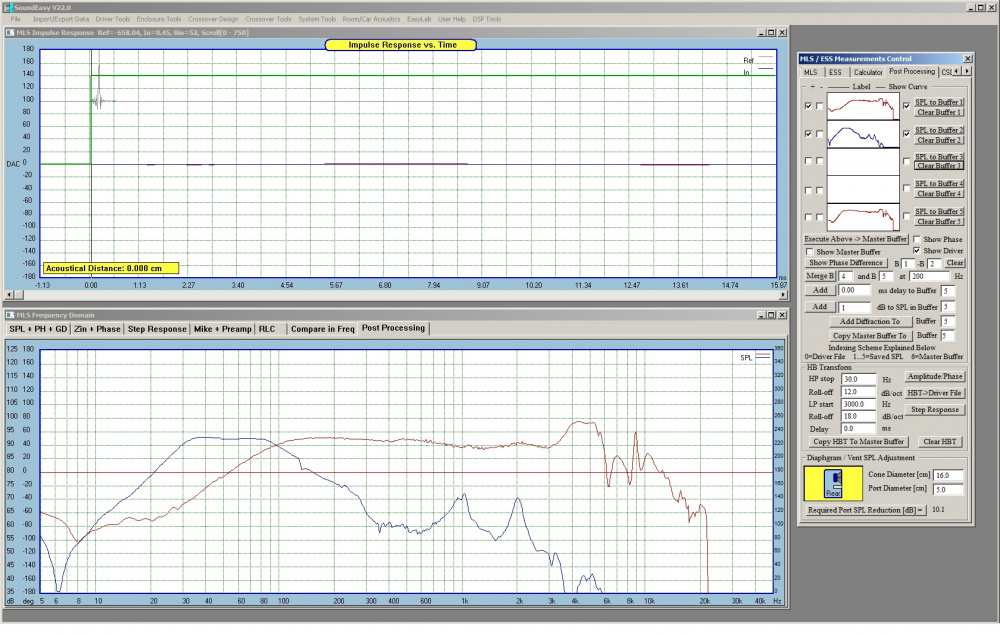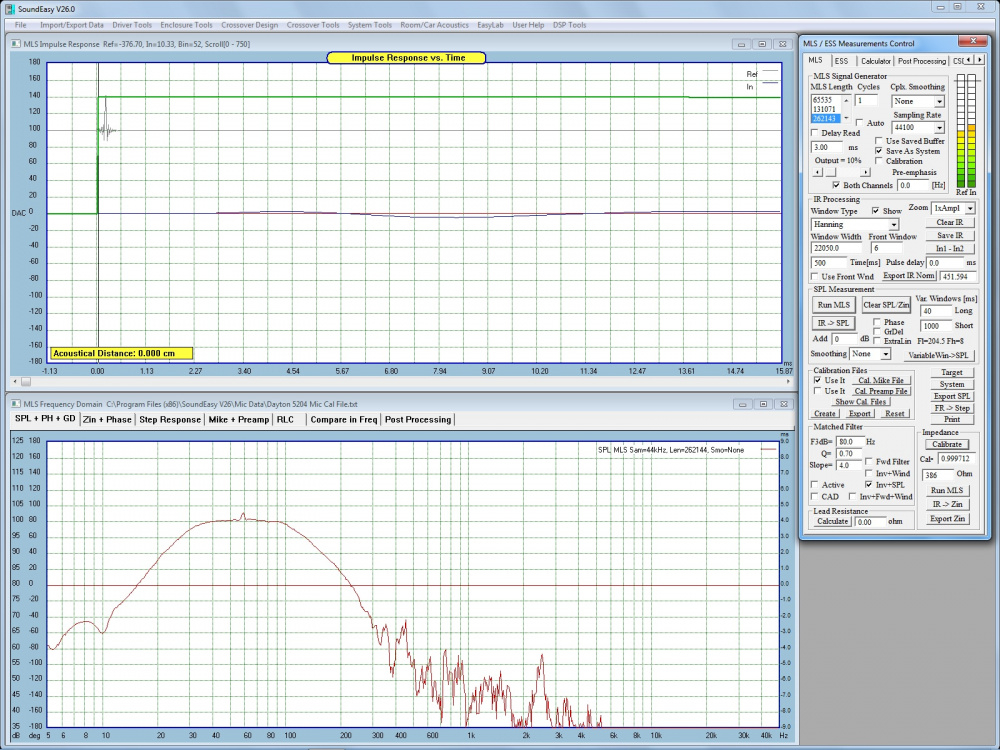Site Links
Howdy, Stranger!
It looks like you're new here. If you want to get involved, click one of these buttons!
Quick Links
Categories
In this Discussion
Who's Online (0)
4th order Bandpass sub for home audio - first time, need some advice on drivers, etc.
I have a concept in mind that would include a 4th order bandpass sub. I would use a straight port around 4" diameter - you can think of it as a box with the port sticking completely out of it. The end of the port will terminate in a panel via a flare.
I've never designed or build a bandpass sub before so I would like some guidance on driver Qts, best practices for designing one, etc. Any tips would be appreciated. I would like to use one or two smaller drivers e.g. not larger than 8" class. There is currently not a limit on the box size but probably 2cuft might be a practical first guess, unless that is way too small. EQ and crossover would be active with a dedicated amp. There will be one of these per side. I would like to cover a band of 35Hz ish (lower is OK) to 100Hz (F3 points).
I can use Unibox to make design choices but need some pointing in the right direction. TIA!

Comments
You may lose considerable output sensitivity to get an upper rolloff to 100Hz if you plan on getting the response without EQ.
With higher mass drivers as subs go, it can be tough to get there. You'll want a driver that will perform well in a sealed volume, so higher xmax is also a likely quality and boost will likely be required to reach 35Hz, especially since you are wanting a higher lowpass.
When I did the Overdrive10, the bandwidth was about 35-65Hz, and boost was required to get lower. The tuning result was approximately 50Hz, IIRC. The front tuning usually dictates the range in which the rolloff will start, and is normally north of the 50% mark in terms of bandwidth.
Bandpasses are interesting devices. They are low distortion, filtering out the bad driver issues. However, if a driver failure has initialized, you won't know unless it sounds different. If using a port, they can be quite noisy and usually require considerable cross-sectional area to make them better. For this reason, most vented styles utilize slot ports to vet the vent long and large enough for quiet operation. They also can exhibit much higher group delay if not optimal.
That said, I really like my Overdrive10, and it amazes me. I will say that the PR exit fixes some of the problems with a vented bandpass like port noise, and allows smaller volumes at the finish line.
InDIYana Event Website
I've built 2 4th order bandpass subs. One was for the 2018 iron driver contest and I used the Dayton DC200-8 woofer.
https://parts-express.com/Dayton-Audio-DC200-8-8-Classic-Woofer-295-310?quantity=1
The sim came out very close to the measurements with a test box.
There was no LP filtering on the woofer.

Link to build pdf document.
https://drive.google.com/open?id=13rVaY5qNFCtwkroHP6zbyo3SbfDc9wXJ
The second system used the MCM-5670 woofer.
https://newark.com/mcm-audio-select/55-5670/8-die-cast-woofer-8-ohm-rubbber/dp/95Y2936
This was the FR driven by a plate amp with the LP set at 190Hz.

Link to build.
https://diy.midwestaudio.club/discussion/1800/mcm-55-5670-bandpass-sub
I was really happy with both builds.
Ron
Thanks for the inspiration Ron. Those both look pretty good.
Given the potential drivers that I still have on hand I simmed up a 4th order BP using a Dayton RSS390HO-4, with the MFG parameters, as a first pass go of it in UniBox. I get the following model response with the rear chamber volume = 20L, front chamber = 40L, a 4" tube vent tuned to 45Hz. The first port resonance is not too low in frequency but the peak is high. This is a sim with 200W power input. Driver excursion is well under Xmax and vent velocity peaks at about 20m/s around 30Hz, much lower elsewhere.
Are the chamber volumes on your sim reversed. I get very similar response with WinSpeakerz if I set the rear chamber to 40L and the front chamber to 20L. Both of my bandpass boxes had the sealed section bigger than the ported section.
Oops, good catch Ron! Sorry about that. The parameters should be:
closed box = 45L
vented box = 20L
A single 4"/10cm tubular port 50cm long tunes the vented box to 45 Hz.
With such a small vented chamber it seems like a PR might be a better choice. Unibox is showing huge port resonances starting at about 320 Hz. This causes the response to roll off a bit earlier than 100Hz that is shown in your WinSpeakerz sim.
I worked up the same system using the Basta modeling program. Looks similar to what I got using Unibox, not bad. The system has a volumes of 40L closed, 20L vented, with a 4inch ID port that is 385cm long (about 15.25"). I haven't measured the driver TS parameters so this is just a what-if type of model at this point.
What is the consensus on the port resonance at 250 Hz? Too audible? If I increase the size of the vented chamber by a few liters I can push the frequency up a bit, for example for 26L vented volume the port resonance frequency occurs at 315 Hz. This also makes the system more efficient but the bandwith shrinks a bit.
Here is the Basta results at 500W power input:
I had a big 260Hz port resonance on my "Plumbers Delight" speakers. Before I fixed the problem, I could clearly hear it, but only on certain music that excited the resonance. I fixed the problem with a custom tuned trap. Here is link to the full write up:
https://techtalk.parts-express.com/forum/speaker-project-gallery/1335695-the-plumber-s-delight-indiyana-nanotech-winners
I think with a dedicated amp, EQ, and a LP filter that port resonance could easily be negated.
Maybe, but when the port resonance is very pronounced it is possible to excite it externally, via another driver, if that driver includes the port resonance frequency within its passband.
Hi Bill, using a stub on the port tube of your Plumber's delight is very clever. I have heard of this before. Supposedly it is sometimes used in custom automotive exhaust systems to tame resonances. How easy was it to tune the stub by adjusting stuffing (and length?) by eye using a continuous measurement? How much stuffing (density?) did you end up using, if you can recall?
If I use 4" PVC pipe I can use this exact same approach, so I am very interested to suck up information about it!
Externally? What?
It's a resonant system. Ever blow across an open coke bottle? Same idea. If high enough Q, any energy injected into the system at the resonant frequency is "stored" in the resonance. So if the port terminates near the midrange and has a tall resonance in the midrange's passband, bob's yer uncle.
Damn you uncle Bob!
I did some Googling about the 1/4 wave stub in ports. From what my gray matter can pull together I believe it works like this:
Problem: you have a strong port resonance at the lowest port resonance frequency, F. How to get rid of it?
Solution: This mode is the first longitudinal standing wave in the tube of length L. So the frequency in Hertz should be about c/L where c is the speed of sound. Since the effective length may be longer than the physical length of port tube, L is a bit difficult to know exactly but you can certainly measure F with your microphone. The first mode has a pressure maximum midway along the length L (where ever that is exactly). You tee off of the port tube at this point connecting another length of tube or duct that has a closed end. This is called a "stub". It should be stuffed with absorptive filling, e.g. poly or wool, etc. The length of the stub should start out being about 0.25Fc, or a quarter of the wavelength of frequency F, that pesky tall port resonance we don't like. What happens is that the acoustic pressure occurring at L/2 travels down the stub, reaches the closed end of the stub and reflects back to the main port tube. This causes a new wave to join the main one that is 180 degrees out of phase with the resonance at F, cancelling it. That's the theory of it. Back to the stub. The presence of the adsorptive filling changes (increases?) the speed of sound in the stub so the length is actually less than 0.25c/F but exactly how much shorter is unknown because the effect of stuffing is not well characterized and changes with stuffing density. But hey this is DIY and not a physics exam, so we just start off with the length at 0.25c/F, measure, then shorten the stub a bit and remeasure. Rinse and repeat. Like 4thTry mentions above, you tweak the stub length for the maximum cancellation of the port resonance. And there is that old Uncle Bob again.
I think that the filling is unnecessary to cancel the first resonance but if left unstuffed it would probably generate some new harmonics. So the stuffing is likely to adsorb those higher frequency components so that the stub doe not create any new problems. That's my guess anyway.
Feel free to add to or correct anything above if I went astray.
That sounds pretty much how I calculated my stub or trap system. My BR port was 1.5" inside diameter by 26" long with a 1st port resonance of 260Hz. The calculated length of the 1/4 wave stub was therefore 6.5". So I started out with a stub of about 10" or so and then kept trimming it shorter and shorter on my miter saw, taking NF measurements between trims, until it was about a total length of 8.5" At about the 8.5" stub length, the port resonances disappeared on my NF measurements. I used 1.25" ID PVC pipe for the stub and filled it with a combination of acousta-stuff (40% or so) and Ultratouch denim (about 60% or so). The stuffing was not packed into the stub tightly, but it filled the stub completely and did not move around. I just measured the total weight of stuffing in one of the stubs and it came out to 0.29 ounces. Not much, just enough to fill the stub.
For 260Hz, one quarter wavelength is just over a foot long, unstuffed. The stuffing means you need a shorter length, so reducing to 10" or 8.5" (plus the depth of the pipe cap???) as you mentioned seems about right.
Oops! Brain fart on my part. Quarter wave at 260Hz is 13 inches, not 6.5. Also, my memory of how I did this is not so good either. In checking my notes, I actually started out with a total stub length of about 13 inches and then trimmed it down to about 10.25 inches (not 8.5"). The actual length is a little uncertain, depending on how far you measure going into the PVC "T" connector. Here are a couple pics showing the actual lengths:
I used a slot port resonance trap and found that the resonance trap did not work well when it was not in the center of the port length.